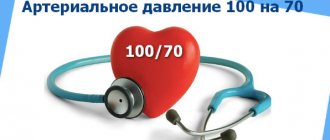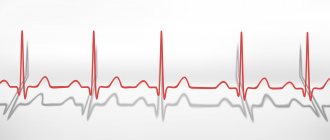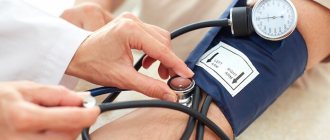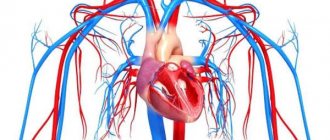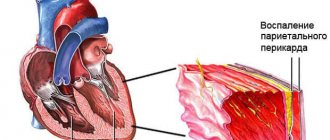Category: Vessels and heart
Blood pressure 100/100 - what to do? Everyone knows perfectly well that normal pressure is 120/80, and the upper figure (with myocardial contraction, systolic pressure) is higher than the lower figures (diastolic pressure). Typically, hypertension is understood as a constant increase in systolic pressure to 140 or more.
However, sometimes with normal upper numbers a rise in diastolic pressure is recorded. Even less common are cases where the a/d is 100/100. This picture of a/d is not always a pathology; below I will consider the causes and variations of such conditions.
Blood pressure 100 / 90 pulse 100 - what does this mean?
The limit of normal diastolic pressure (lower value) is 90 mmHg. Art. Now more and more doctors are paying great attention to the lower a/d numbers. WHO recommends the following classification of hypertension based on diastolic pressure (in mmHg):
- I Art. - 90 - 99;
- II Art. - 100 - 109;
- III Art. - 110 or more.
An a/d reading of 100/90 indicates the opposite process to hypertension—hypotension. A decrease in the upper value to 100 for some people is felt in the form of weakness and drowsiness.
However, a small difference between pressure levels can cause palpitations, dizziness and headaches.
Causes of pressure 100/90:
- stress;
- hormonal imbalances in the initial stage, including iodine deficiency with normal levels of thyroid hormones;
- overeating (blood pressure drops after a heavy meal);
- hypovitaminosis;
- taking antihypertensive drugs in the wrong dose;
- vegetative-vascular dystonia;
- chronic fatigue syndrome.
If, when measuring blood pressure, the indicator 100/90 is detected only occasionally, there is no point in worrying. However, such a level, fixed for a long time, especially if you feel unwell and have an increased heart rate (100 and above), requires consultation with a cardiologist. Often the patient is referred to an appointment with a neurologist or endocrinologist to identify disorders in the body at the initial stage.
If the examination does not reveal organic pathology (hypothyroidism, heart disease, etc.), the patient is prescribed the following treatment:
- herbal remedies - ginseng tincture, eleutherococcus extract;
- active physical activity - gymnastics, regular walks or jogging, aerobics;
- proper nutrition and taking multivitamins;
- correction of the rest regime, sufficient sleep.
The use of soothing herbal remedies with motherwort or valerian is acceptable (especially for VSD). However, to achieve a therapeutic effect, the drugs should be taken for at least 2 weeks, and their long-term use leads, albeit slightly, to a decrease in the systolic level.
What does it mean if blood pressure is 110 over 90
When you see a reading of 110 over 90 on the tonometer, there is no need to panic, because there is only a slight increase in diastolic pressure and a reduction in the pulse difference. Most doctors find this state of affairs quite natural, especially for teenagers and young adults. Occasionally, such failures are possible due to lack of sleep, lack of rest or stress.
This indicator is also typical for professional athletes, due to hypertrophied heart muscle without the presence of hypertension. Experts also recommend not to rush to conclusions and conduct the study again. In the absence of symptoms, the value may be caused by a malfunctioning tonometer or an incorrect measurement.
At the same time, this may be an indicator of a vascular disorder in the arterial bed. A condition in which the tonometer shows 110 to 90 is called, however, in the absence of disorders of the blood vessels and heart, this is not a pathology. Variations of this disease are also possible, depending on individual characteristics: 110 to 85, 105 to 90, 105 to 85.
Prevention
If there are a sufficient number of medications for the treatment of hypertension, then in the case of hypotension the choice is more modest. The main preventive measures are aimed at normalizing lifestyle, regimen and nutrition. Follow these guidelines:
- Proper nutrition. The diet should contain enough fresh fruits and vegetables, protein products. It is recommended to give up fatty, fried, fast food, and soda.
- Active lifestyle. Find time for light exercises even during your workday.
- Adequate rest - you need to sleep at least eight hours a day.
- It is important to give up bad habits.
And also read on our website what to do if your blood pressure is: 90 over 50 , 90 over 60 , 90 over 70 and 100 over 50 ?
What to do?
When the tonometer shows a critical value of 100/90, you should first make sure it is working properly and measure the pressure again. If the indicators remain the same, you should immediately call an ambulance. While waiting for specialists, you can take the following measures on your own:
- calm down and take a lying position;
- open windows for fresh air;
- normalize breathing;
- do not make sudden movements.
After examining and identifying the causes of hypotension, the doctor will prescribe the necessary treatment. In addition to basic therapy, the patient should adhere to the following recommendations:
- Follow a special diet. Eliminate fried and smoked foods, spicy and salty foods from your diet. Eat more fruits and vegetables.
- Quit alcohol and smoking.
- Drink at least one and a half liters of water per day.
- Limit physical activity.
Traditional medicine offers a number of safe means to strengthen the body and maintain normal blood pressure:
- for the cardiovascular system, beet juice diluted with water is used;
- Kidney diseases with a blood pressure of 100/90 are treated with a decoction of St. John's wort, oregano, sage and motherwort.
- Lingonberry juice with honey will help normalize low blood pressure;
- For pathologies of the thyroid gland, an infusion of valerian root is useful.
However, traditional methods of treatment are permissible only after consultation with a doctor.
Blood pressure 100 over 100 - what does this mean?
Fixing pressure at 100/100 does not always indicate the development of pathological processes. Normally, this pressure is recorded in athletes and people engaged in physical labor.
Blood pressure is 100 over 100, what does this mean? In most cases, such a/d indicates myocardial overstrain and narrowing of the lumen of the arteries. Characteristic symptoms for a/d 100/100:
- dizziness and mild headaches;
- decreased vision - fogginess, blurred visual image;
- dyspnea;
- periodic nosebleeds.
Although the symptoms do not seem so dangerous, a pressure of 100/100 indicates the onset of the development of a rather serious disease - atherosclerosis.
It is at these a/d levels that atherosclerotic plaques begin to form in the arterial wall. High blood pressure indicates already developed atherosclerosis. That is why it is so important to record a/d 100/100 in order to promptly begin treatment of atherosclerosis and stop as much as possible the pathological damage to the arteries, which often leads to stroke and heart attack.
The same lower and upper pressure of 100 cannot be independently treated with various antihypertensive drugs. Uncontrolled use of blood pressure-lowering drugs can lead to a sharp drop in systolic readings and fainting.
Treatment is prescribed only by a cardiologist and includes the following drugs:
- diuretics (Indapamide, Hypothiazide) - diuretics are often included in combination drugs;
- adrenergic blockers (Prazonin, Atenolol, Metoprolol, Capvediol) - normalize diastolic pressure by reducing the load on the myocardium;
- ACE inhibitors (Captopril, Enalapril) also reduce systolic pressure, so they are rarely used at an upper (heart) pressure of 100.
Why is the pulse pressure 10 units?
A pulse pressure of 10 units may be a sign of a serious illness, but only a qualified specialist can determine the correct cause.
If the pulse is normal (60)
With a pressure of 100 to 90, the pulse may be normal or rapid. If the pulse is normal, then there is no reason to worry only in the first trimester of pregnancy. In all other situations, you should consult a doctor, since such blood pressure may be a sign of a developing disease. A rapid pulse does not always accompany diseases associated with isolated arterial hypertension - this fact must be remembered if you value your health.
With a high heart rate (90–100 and above)
Very often, a pressure of 100 over 90 accompanies a pulse of 90 or higher - this is a sign of the appearance of tumors in the body, the development of respiratory diseases, increased activity of the thyroid gland, or the development of anemia.
Consequences
Arterial hypotension can manifest itself as a symptom of another disease, for example, a heart attack, disorders of the adrenal glands, bleeding in the gastrointestinal tract.
If the heart does not cope with its function fully and does not push blood with the required force, this negatively affects the functioning of all organs and systems of the body . If you do not seek help, irreversible pathological processes may develop, even leading to death.
Hypotension can lead to the following complications:
- blurred vision;
- memory impairment;
- cardiac dysfunction;
- change in coordination of movements;
- decreased physical endurance;
- loss of consciousness.
The most dangerous consequence of a sharp decrease in blood pressure is cardiogenic shock. It manifests itself with the following symptoms:
- the skin becomes very pale and cold;
- a marble pattern appears on the skin;
- cyanosis of the lips is noted;
- concerned about tachycardia, shortness of breath, weakness;
- increased anxiety, fear of death;
- loss of consciousness.
Cardiogenic shock can be fatal, so it is necessary to call an ambulance as quickly as possible.
Possible complications and consequences
Complications develop against the background of excess diastolic pressure, which indicates a lack of blood supply in the circulatory system. If you do not pay attention to this in a timely manner, the increase in pressure will progress.
This leads to thinning of the artery walls and the formation of atherosclerotic plaques. Subsequently, persistent hypertension, atherosclerosis, and hypertensive crisis develop. After this, there is a risk of more dangerous conditions - stroke and myocardial infarction. And this entails death.
Lower pressure at 100
A diastolic a/d reading of 100 (the pressure in the blood vessels after the heart contracts) is considered initial stage hypertension. This always confirms a narrowing (stenosis or temporary spasm) of the lumen of the arteries, which ultimately leads to poor circulation.
Reasons for low blood pressure 100:
- kidney pathology;
- diseases of the thyroid gland, adrenal glands, pituitary gland;
- heart diseases;
- alcohol even in small quantities;
- obesity;
- eating too salty foods.
A lower pressure of 100 can be felt by patients in different ways. It all depends on the top indicator.
Characteristics of the problem
A blood pressure of 100 over 90 is a deviation from the norm, which is considered to be a value of 120 over 80.
A decrease in the upper indicator in combination with a slight increase in the lower indicator is diagnosed quite rarely.
Note! The peculiarity of the pathology is that it is more common in women under 40 years of age, although it also occurs in old age.
If a blood pressure of 100 over 90 does not cause discomfort and does not manifest itself in any way, then it does not pose a great danger. In such cases, abnormal pressure occurs due to excessive fatigue, lack of sleep, and a radical change in climatic conditions. In the first trimester of pregnancy, it also does not cause concern, since it is considered acceptable.
Important! A pressure of 100 to 90 is a consequence of hypovitaminosis, a sedentary lifestyle, iodine deficiency, excess salt consumption and unhealthy foods.
You should worry when the tonometer shows blood pressure readings of 100/90, but the person feels sick and tired. The small difference between values occurs as a result of a decrease in the speed or strength of blood flow due to the development of internal diseases.
Chronic increases in lower blood pressure are especially dangerous. Due to a decrease in vascular tone, they narrow, the supply to the tissues of vital organs is blocked, which leads to disruptions in their functionality.
A value of 100 to 90 is the cause of the appearance of fatty plaques on the inner surface of the vascular walls. Their rapid growth is fraught with complete blockage of the lumens of the arteries, which leads to early atherosclerosis and strokes.
Blood pressure 130/100
With a normal systolic reading and an elevated diastolic reading - pressure 130 over 100 - a person can feel quite normal. Only some people report increased heart rate.
Obvious signs of the disease appear at the top numbers of 140 or more.
- Headache (most often in the back of the head), nausea, compression behind the sternum, weakness - all this indicates a pressure of 150 to 100 or higher.
If the upper a/d indicator slightly increases, doctors recommend adjusting your lifestyle. Quitting alcohol and cigarettes, limiting salt and daily fluid volume, eliminating fatty foods and sweets can significantly reduce slightly elevated blood pressure even without drug therapy.
What do tonometer readings mean?
First of all, you need to understand what upper and lower blood pressure (blood pressure) are:
- The upper pressure is called systolic, as it means systole (the period of contraction). The tonometer shows the blood pressure that occurs as the heart muscle contracts. This opens the heart valves. In simple terms, a value of 100 records the force of blood fluid entering the vessels when the heart muscle contracts. The normal systolic reading is 110-120 mmHg. Art. If the number is lower, then this indicates a low level of ejected blood volume, that is, low pressure.
- The lower pressure is called diastolic because it is recorded during diastole (relaxation of the heart muscle). The valves then close. To put it simply, the value reflects the strength of blood filling when the heart muscle relaxes. Normal values include a value of 70-80 mm Hg. Art. A figure of 90 is too high.
The pulse difference between the values plays a huge role. The normal pressure is 120/80, since there is a difference of 40 points between them. But the acceptable range is 30-50 points. With a pressure of 100/90, the pulse value is 10, which is much lower than normal.
It must be said that the upper values of 100 in some cases are not considered a deviation, since for many people such blood pressure is the norm. But the lower 90 clearly indicates high blood pressure. This occurs quite rarely, but most often in women.
If a person’s working blood pressure is 110-120x70-80, then an indicator of 100 occurs with blood loss, heart disease, adrenal glands, and blood vessels. Often, the pressure changes during gestation in the 1st trimester, which is not a deviation. An increase in lower blood pressure indicates diseases of the cardiovascular system, kidneys, and thyroid gland. It also occurs during pregnancy, after suffering stress.
How does a person feel?
At first, a person may not notice an increase in blood pressure. The problem is determined during a routine examination. In the absence of treatment, lower blood pressure does not decrease and symptoms appear:
- nausea, vomiting;
- chest pain;
- tachycardia;
- dizziness;
- visual impairment;
- nosebleeds;
- difficulty breathing;
- headaches;
- noise in ears.
Such pressure surges put a strong strain on the cardiovascular system. Due to the inability to relax, the muscles become toned, disrupting blood flow in the body. If left untreated for a long period of time, the following occurs:
- stroke;
- hypertension;
- atherosclerosis;
- chronic renal failure.
The most dangerous consequence of this condition is cirrhosis of the liver, pulmonary edema and death.
Aged people
The worst state of health during pressure surges is observed in older people. To cope with the problem, the doctor selects a course of treatment for each patient individually, based on the characteristics of the body. Therapy will help eliminate the negative consequences of the same blood pressure.
During pregnancy
Blood pressure often changes during pregnancy due to hormonal changes. Don’t worry if the same blood pressure readings last up to 3 hours. A condition that is regular in nature must be eliminated with drug therapy. Without treatment, the risk of complications for both the woman and the child increases.
Symptoms
Often in the early stages of the development of pathology there are no pronounced symptoms. There is general weakness, which can easily be mistaken for simple fatigue and the patient does not immediately seek help. As the condition worsens, the following symptoms begin to appear:
- headache predominantly in the occipital region;
- dizziness;
- swelling and bruising under the eyes;
- tinnitus;
- sweating;
- nausea and vomiting;
- cardiopalmus;
- increased anxiety;
- insomnia;
- numbness of the limbs;
- nosebleeds.
Untimely stabilization of pressure leads to the rapid development of hidden diseases that can cause significant harm to human health.
Blood pressure 150/100
What to do if the pressure is 150 to 100? First of all, you should understand that you are developing hypertension. In this case, not only the arteries suffer, but also the heart itself.
Increase in systolic pressure to 150 mmHg. Art. indicates depletion of the myocardium, which cannot cope with the volume of circulating blood. Also, such pressure may indicate blood thickening and an increased risk of blood clots.
How to reduce pressure 150 to 100:
- First, mild antihypertensive drugs are prescribed. These include Captopril and Enalapril.
- For some patients, most often with hypertension caused by impaired renal function, these drugs have minimal effect. In such cases, the doctor prescribes Verapamil, Nifedipine (sharply reduces blood pressure and provokes arrhythmia, therefore it is prescribed as an emergency treatment), Lorista, combination drugs Atacad, Amprilan XL, Ko-Renitek and others.
- The treatment regimen must include blood thinners - Cardiomagnyl (magnesium strengthens the myocardium, and acetylsalicylic acid in a small dose prevents the formation of blood clots), ThromboACC, regular Aspirin in a cardiac dose.
The choice of drug and its dosage is adjusted individually based on the analysis of A/D monitoring throughout the month. However, all antihypertensive drugs are only symptomatic treatment. It is important to identify the cause of changes in pressure and stop the pathological process.
Tags: hypertension, heart
- Male infertility - types, causes and treatment, drugs
- Gas formation in the intestines: causes and treatment,…
- Erectile dysfunction - causes and treatment,...
- Atrial fibrillation - causes, symptoms and...
- Glaucoma - causes, symptoms and treatment, disease prevention
- Scoliosis - causes, symptoms by degree, treatment,…
Why are speculations so dangerous?
Hypertension and hypotension are ailments that, as it turns out, not only doctors understand. But also neighbors, relatives and even random people met in line at the clinic. Sound familiar? And this is not funny, but rather dangerous.
As soon as you shift responsibility for your health to those who are not a priori specialists, the situation gets out of control.
Let's debunk the most common speculations about blood pressure:
- If blood pressure rises sporadically, there is nothing to worry about. The danger lies in the free interpretation of this definition – “episodic”. If you ran for the bus, if you experienced extreme stress, if you had to work hard physically, your blood pressure will quite predictably rise. But this, in this case, will be a physiological reaction. It’s a different matter if you completely accidentally measured your blood pressure, and the tonometer showed, for example, 140/90. At the same time, nothing bothers you, there is no reason to worry. The next day they measured my blood pressure, and it was already normal. Worry? Yes. There is reason to think about it, and definitely - go to the doctor.
- The disease is mainly inherited. Yes and no. There is an expression: “it affects even those who are not affected.” If you have virtually no history of hypertension in your family, congratulations, you have good genetic protection, but this is not a guarantee. Hypertension can affect anyone, and young age is not a hindrance to the disease.
- Working pressure is the indicator at which you feel normal. A most dangerous installation! Many people feel quite well when their blood pressure rises to 160/90, but this does not mean that you can do nothing. Vascular accidents do not “look” at your well-being, therefore heart attack and stroke creep up not only on those who suffer from headaches and dizziness, but also on hypertensive patients without complaints about their health.
Whatever direction your usual pressure changes, always react to these changes. Contact your doctors promptly.
Remember that mild hypertension can be corrected without drugs, hospitals or large financial costs.
Stabilization Tips
What to do to normalize blood pressure levels? To restore normal blood pressure and combat hypotension, it is recommended:
- Maintain regular sleep of 10-11 hours.
- When the pressure is 90 to 40, it is necessary to allocate time for daytime sleep.
- Refrain from abruptly getting out of bed.
- Regularly ventilate the interior.
- Enrich your diet with foods high in vitamin C and B1, B12.
- Eat at least 4 times a day.
- Do morning and evening exercises.
Prevention of low blood pressure and supporting the body during hypotension are necessary stages of treatment. If there is insufficient attention on the part of the patient and no lifestyle changes, drug therapy may be ineffective.
Blood pressure is one of the main indicators that characterize the general condition of the body. It consists of systolic and diastolic, which are normally 110–130 and 65–90, respectively. A blood pressure of 90 over 40 is considered very low and can cause a number of unpleasant symptoms.
Reasons for the development of pathology
As a rule, blood pressure is 100 per 100 mmHg. Art., always develops against the background of other diseases. Often it is a symptom of a pathology that appears in the body. Doctors have determined that this disorder occurs due to the following serious problems:
- kidney diseases. Pathological disorders in this organ lead to narrowing of the renal arteries, which always provokes an increase in pressure. As a rule, the lower value increases with chronic glomerulonephritis;
- improper functioning of the endocrine system;
- pathologies of the heart and blood vessels;
- hereditary predisposition;
- neoplasms in the adrenal glands. These formations can be both malignant and benign. Regardless of their nature, the tumor provokes the production of adrenaline, which constricts blood vessels and at the same time increases blood pressure;
- hypothyroidism
Unfortunately, it is often quite difficult to determine the root cause of increased diastolic pressure. That is why the patient is diagnosed with “isolated hypertension.” This pathology can be triggered by many reasons that a person encounters in everyday life:
- emotional tension and stress;
- excess body weight;
- excessive drinking;
- high salt intake;
- poor quality and unbalanced nutrition.
Important! So that the tonometer is guaranteed to show a blood pressure of 100 per 100 mHg. Art., it is better to use an electronic device, since a mechanical one will not be able to show absolutely accurate data.
Drug treatment
Increased diastolic pressure is a serious disease that requires competent drug therapy. Thiazide diuretics are used for treatment to get rid of swelling and excess fluid in the bloodstream. The most common drug in this group is Hypothiazide.
Alpha-blockers allow you to control blood pressure; Parozosin is considered a favorite drug for cardiologists. They affect specific receptors, thereby achieving a hypotensive effect. Angiotensin-converting enzyme inhibitors are used: Captopril, Lisinopril.
Drug treatment uses drugs aimed at combating various negative processes.
Symptoms of pathology
Violations of diastolic pressure are usually detected during a commission or during treatment of another disease. This happens because the symptoms are not very pronounced.
Important: Despite mild manifestations, there is a negative effect on the heart and blood circulation. If treatment is not started on time, the consequences can be very serious, including thrombosis.
In the initial stages there are no symptoms. If therapeutic measures are not taken, the following manifestations of pathology are observed:
- nosebleeds;
- “floaters” in the eyes;
- headache;
- development of clouding of consciousness;
- dizziness;
- pain in the heart;
- difficulty breathing;
- pulse above 100 beats. /min.
Treatment
Since the causes and treatment are individual for each person (depending on the severity and clinical manifestations), medications and folk remedies are prescribed after assessing the patient’s condition.
Drug therapy
Depending on the blood pressure parameters, the drugs are also different:
- vasodilators - normalize blood circulation and promote relaxation of blood vessels;
- diuretics (for swelling) - remove fluid from the body, reduce blood pressure;
- calming - stabilize the emotional state;
- cardiac glycosides - normalize heart rate.
You must take heart medications strictly as prescribed by your doctor (following the rules of administration and dosage)!
Folk remedies
When the pressure is 100 to 100, the use of traditional medicine as an auxiliary treatment method helps.
To lower blood pressure, medicinal herbs are used in the form of tinctures, decoctions, and teas:
- hawthorn - improves heart function and normalizes pulse;
- calendula - has a diuretic property, reduces blood pressure;
- corn - improves blood circulation;
- mistletoe - relieves spasm of blood vessels;
- motherwort, lemon balm - calms the nervous system.
The use of any medicinal herbs should be agreed with a doctor due to individual intolerance to plants and side effects!
